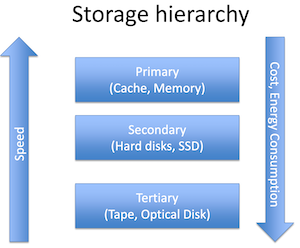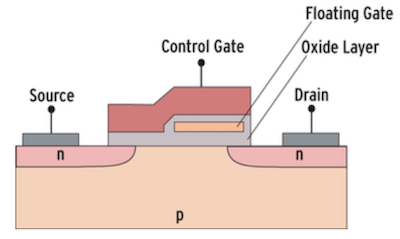Storage systems
Storage Device
Hierarchy

Characters
- Capacity(bytes) - How much data it can hold
- Cost($) - Price per byte of storage
- Bandwidth(bytes/sec) - Number of bytes that can be transferred per second; read and write bandwidth may be different
- Latency(sec) - Time elapsed, waiting for response/delivery of data
Basic Function : CRUD
- C(reate)/write
- R(ead)
- U(pdate)/overwrite
- D(elete)
Some terms
- Access times: Time taken before drive is ready to transfer data 一般来说,物理设备(硬盘,内存..)在进行数据的转换前需要索引到目标位置, 内存-纳秒 SSD-微秒 HDD-毫秒
- Access pattern: how storage read/write data
- Sequential: Data to be accessed are located next to each other or sequentially on the device
- Random: Access data located randomly on storage device
- Completion Time:Time to complete an read/write operation
- CompletionTime = Latency + Size/Bandwidth
- Depends on lots of factors(device, operation type, access pattern…)
Note: 这里主要讨论HDD和SSD
Hard Disk Drive
Organization

- One or more spinning magnetic platters, typically two surface per platter
- Data stored in tracks
- Disk arm positions over the radial positon - swings across tracks but don’t extend
- Data is read/written by disk head as platter spins
Hard disk head movement while copying files between two folders:
https://www.youtube.com/watch?v=BlB49F6ExkQ
Physical characteristics
- 3.5” (diameter, common in desktops), 2.5” (common in laptops)
- Rotational Speed: 4800/5400/7200/10000 RPM (rotations per minute)
- Between 5-7 platters
- Current capacity up to 10TB
Data Storage
- 1 platter is divided into a number of tracks
- 1 tracker is divided into N fixed size sectors
- sector size: 4KB
- Entire sector is written “atomically” -> sector为最小的操作单元,所以不论读写都首先进行sector的寻址
Address Method - CHS(cylinder-head-sector)
overview
CHS is an early way to address a sector. (LBA(Logical Block Addressing) is more common now.)

举个例子:
#cylinders: 256
#heads: 16 (i.e., 8 platters, 2 heads/platter)
#sectors/track: 64
sector size = 4KB
=> capacity of the drive: 2^8 * 2^6 * 2^2* 2^10 * 2^4 = 2^30 = 1GB
address step
According to CHS, data can be located before transferring, then data can be transferred
- Wait for the disk haed on right track - seek time
- On average seek time is about 1⁄3 max seek time

- wait for the right sector to rotate under the head. - rotational latency
- On average: about 1⁄2 of time of a full rotation
- example: Assume 10,000 RPM (rotations per minute) 60000 ms/ 10000 rotations = 6ms / rotation
Data Operation
T = T_seek + T_rotation + T_transfer
T_seek : Time to get the disk head on right track
T_rotation :Time to wait for the right sector to rotate under the head
T_transfer: Time to actually transfer data
T_transfer
Assume that data will be transferred: 512KB, 128 MB/sec transmission bandwidth
Transfer time: 512KB/128MB * 1000ms = 4ms
Actual Bandwidth
Actual Bandwidth = data / actual time ,所以一般情况下实际带宽会小
数据传输中的block和sector区分
- Sector is the basic unit of hard disk dirve
- Block is the basic unit of file system
- Block has 1 or more sectors (in this course, assuming one block = one sector)
硬盘本身没有block的概念,block概念存在于文件系统的概念中,文件系统是一个块一个块的读取数据,如果是按照一个sector一个sector的来读数据,太慢了,所以才有了block这样一个逻辑块的概念。
不同access pattern对读写的影响
- Sequential operation:
- May assume all sectors involved are on the same track
– need to seek to the right track or rotate to the first sector (一次seektime)
– But no rotation/seeking needed afterwardSSD
- May assume all sectors involved are on the same track
- Random operation:
- May assume all sectors are on different tracks and sectors (多次seektime)
1 | |
Soild State Drive
Organization

SSD contains a number of flash memory chips

chip -> dies -> planes -> blocks -> pages (rows) -> cells
Characteristics
- All electronic, made from flash memory
- Limited lifetime, can only write a limited number of times.
- More expensive, less capacity - 3 times or more expensive
- Significantly better latency: no seek or rotational delay
- Much better performance on random (however, write has much higher latency than read )
Data Storage
- Cells are made of floating-gate transistors : By applying high positive/negative voltage to control gate, electrons can be attracted to or repelled from floating gate
- State = 1, if no electrons in the floating gate
- State = 0, if there are electrons (negative charges)
– Electrons stuck there even when power is off
– So state is retained
- Data in SSD are represented by the ‘01010…’ formats, that is the state of the electrons

Operations
Read
- Electrons on the floating gate affect the threshold voltage for the floating gate transistor to conduct
- Higher voltage needed when gate has electrons

Steps:
- Apply Vint (intermediate voltage)
- If the current is detected, gate has no electrons=> bit = 1
- If no current, gate must have electrons => bit = 0
Page is the smallest unit that can be read
Write and Erase
Write and erase
- Write: 1 => 0 (get electron)
- Apply high positive voltage (>> voltage for read) to the control gate
- Attract electrons from channel to floating gate (through quantum tunneling)
- Page is the smallest unit for write
- Erase: 0 => 1 (make electrons empty)
- Need to apply much higher negative voltage to the control gate
- Get rid of electrons from floating gate
- May stress surrounding cells(dangerous to do on individual pages)
- Block is the smallest unit for erase
P/E cycle
P/E cycle: Data is written to cells (P) and then erased (E)
Every write & erase damages oxide layer surrounding the floating-gate to some extent
- Page is the smallest unit for read and write (write is also called program, 1->0)
- Block is the smallest unit for erase (0->1) – i.e., make cells “empty” (i.e., no electrons) (关于为什么使用block作为最小擦除单元:SSD的物理结构导致,擦除过程会作用到整个block施加高电压,将电子吸引出来)
本博客所有文章除特别声明外,均采用 CC BY-SA 4.0 协议 ,转载请注明出处!